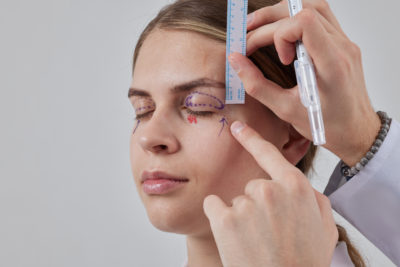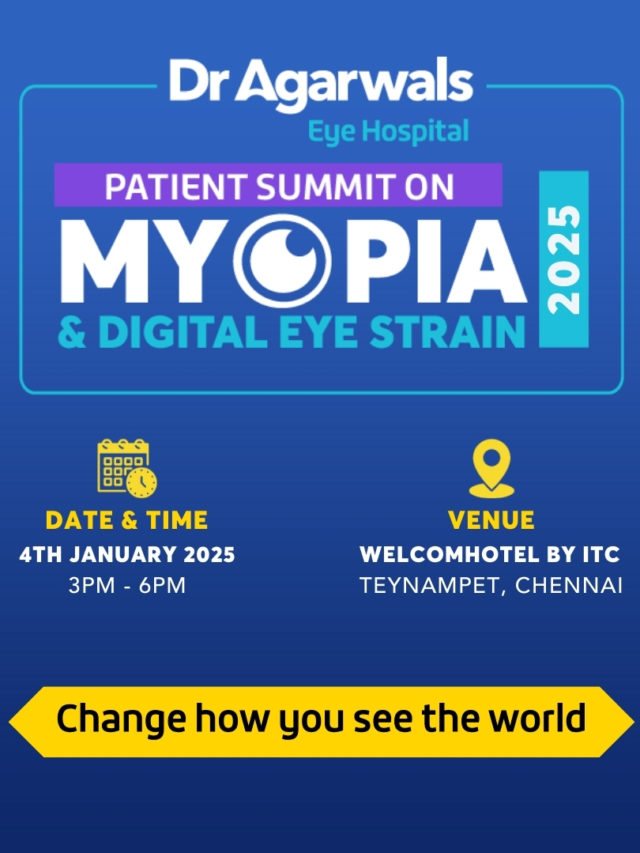Key Takeaways
- Thyroid-related disorders may impact your eyes, and cause vision changes or changes in appearance.
- Thyroid eye disease (TED) is an autoimmune disorder, or a disorder where the immune system attacks the tissues of the eye.
- Symptoms of TED include, red, puffy eyelids, a stare appearance, bulging eyes, discomfort, and double vision.
- Treatment options include corticosteroids to reduce inflammation or surgery to correct eye bulging or protrusion.
- Quitting smoking and restoring thyroid function may also serve to manage this disease.
Dr Akshay Nair, a leading oculoplastic surgeon with over 15 years of experience in ophthalmology, shares clinical insights on how thyroid dysfunction can affect both eye appearance and vision. Drawing from his extensive work managing thyroid eye disease (TED), Dr Nair explains the symptoms, risks, and treatment considerations every patient should be aware of.
What is thyroid eye disease?
In certain thyroid disorders, an overproduction of thyroid hormones can lead not only to systemic symptoms like palpitations and weight loss, but also to eye-related issues such as bulging eyes, double vision, dryness, and eye muscle inflammation. This disease process may be autoimmune. This means that the immune system, which normally helps to defend your body against disease, suddenly decides that the body’s healthy cells are foreign. Effectively, the immune system attacks healthy body cells.
During this, the immune system also attacks the soft tissue, the muscles and the connective tissue around the eye, leading to inflammation, swelling, engorgement and eventually fibrosis. This is known as thyroid eye disease (TED), thyroid-associated orbitopathy (TAO) and Graves orbitopathy.
What happens in thyroid eye disease?
As mentioned earlier, Thyroid Eye Disease is an autoimmune disease. The autoimmune process also affects the tissues around the eye. There is inflammation and engorgement of the soft tissue and eye muscles.
- The upper and lower eyelids appear red and puffy. (eye lid bags)
- The upper and lower lid muscles contract and appear as if the person has a constant staring look. (lid retraction)
- Swelling of the orbital fat and eye muscles can push the eye forward, causing a bulging appearance known as proptosis (or exophthalmos). This forward displacement can lead to dryness, difficulty closing the eyes, double vision, and, in severe cases, damage to the optic nerve affecting vision.
- Because of the enlarged and inflamed muscles, there may be pain and double vision. (Diplopia)
- Restoration of the normal thyroid function
- Cessation of smoking
- Medical and Surgical Treatment During the inflammatory phase of Thyroid Eye Disease, your eye doctor may prescribe corticosteroids to you. These are medicines that suppress the immune system in order to reduce the amount of inflammation. This may be given orally or intravenously (IV). This is usually given when the swelling around the eye is vision-threatening.
Once the inflammatory phase is over, there may be residual bulging of the eyes or retraction of the eyelids. This may require surgical treatment of the lids or the orbit (the bony socket) or both.
The orbit surgeries, which involve pushing the eyes back into the socket, also known as orbital decompression surgery, are performed under general anaesthesia and have a healing period of about 3-4 weeks, after which the final outcome can be assessed.
Causes and Symptoms of Thyroid Eye Disease
Thyroid Eye Disease (TED), also known as thyroid orbitopathy or Graves’ orbitopathy, is an autoimmune inflammatory disorder affecting the tissues around the eyes. It often occurs in individuals with thyroid dysfunction, particularly Graves’ disease.
Thyroid eye disease symptoms
TED affects both the function and appearance of the eyes. Symptoms vary in severity and may develop gradually or suddenly.
Double Vision
Misalignment of the eye muscles can cause diplopia (double vision), especially when looking in specific directions. This can impact daily tasks like reading or driving.
Bulging Eyes
Also known as proptosis, bulging occurs due to inflammation and swelling behind the eye. It can make blinking difficult and increase the risk of exposure-related damage.
Eye Pain
Pain may result from pressure behind the eye or when moving the eyes. Discomfort can worsen with upward or sideward gaze.
Gritty Eyes
Many patients experience a gritty or sandy feeling, often due to exposure from incomplete eyelid closure and surface dryness.
Light Sensitivity
Photophobia is common in TED and may result from inflammation of the ocular surface or corneal exposure.
Blurred Vision
Blurred or fluctuating vision can be due to corneal dryness, swelling of ocular tissues, or optic nerve involvement in advanced stages.
Puffy Eyelids
Swelling of the eyelids is caused by inflammation and fluid retention. This may be more pronounced in the mornings or after prolonged eye use.
Bloodshot Eyes
Dilated blood vessels from ongoing inflammation can make the eyes appear red and irritated.
Eyelid Retraction
This hallmark sign of TED makes the eyes appear more open than usual. It results in greater exposure, leading to discomfort and dryness.
Causes of thyroid eye disease
TED occurs when the immune system mistakenly attacks the tissues surrounding the eyes, including muscles and fat, causing inflammation and swelling.
Autoimmune Condition
TED is an autoimmune response where immune cells target orbital tissues. The same process that affects the thyroid gland also impacts the eye structures.
Graves’ Disease
Most TED cases are linked to Graves’ disease, an overactive thyroid condition. However, TED can also occur in people with normal or underactive thyroid function.
Genetic and Environmental Factors
Genetics may play a role, with some individuals having a higher predisposition. Environmental factors such as stress and infection may also influence disease onset.
Smoking
Smoking significantly increases the risk and severity of TED. It reduces the effectiveness of treatment and slows the healing of inflamed orbital tissues.
How Thyroid Eye Disease Affects Your Vision
TED affects visual function in multiple ways. Inflammation and swelling can push the eyeball forward, stretch the optic nerve, or restrict eye muscle movement. These changes may result in double vision, blurred vision, or, in severe cases, optic nerve compression that threatens permanent vision loss. Ongoing monitoring is critical to protect eye health.
Diagnosis of Thyroid Eye Disease
Early diagnosis allows for timely intervention and can help limit complications.
Clinical Examination
An ophthalmologist evaluates signs such as eyelid position, eye movement, proptosis, and ocular surface changes. Visual acuity and colour vision tests may also be done.
Imaging Studies
CT or MRI scans of the orbit help assess inflammation, muscle enlargement, and optic nerve compression. Imaging guides treatment decisions.
Blood Tests
Thyroid function tests (T3, T4, TSH) and antibody panels (TSH receptor antibodies) help confirm thyroid dysfunction and autoimmune activity.
Treatment Options for Thyroid Eye Disease
Treatment depends on the activity and severity of the disease. A multidisciplinary approach involving endocrinologists and ophthalmologists is essential.
Medical Treatment
Corticosteroids (oral or intravenous) are often prescribed to reduce inflammation in active disease phases. They may be used in tapering doses under close supervision.
Smoking Cessation
Stopping smoking is a key part of treatment. It not only slows disease progression but also improves the response to other therapies.
Orbital radiation
Targeted radiation may be used to reduce inflammation and muscle swelling in patients unresponsive to medication. It’s typically offered in moderate to severe cases.
Eye drops
Lubricating eye drops help relieve dryness and irritation. They are especially useful for those with lid retraction and surface exposure.
Rituximab
This monoclonal antibody is used in severe or steroid-resistant TED. It targets immune cells contributing to inflammation.
Tocilizumab
This biologic therapy is another option for active TED, particularly in patients who do not respond well to corticosteroids.
Laser Therapy
Laser procedures may be used to address complications such as glaucoma or to reshape tissues in later stages.
Surgical Treatment
Surgical options include orbital decompression, strabismus correction, or eyelid surgery. These are typically considered once the disease has stabilised.
Post-Treatment Care and Recovery
Recovery after TED treatment depends on the intervention. For those undergoing surgery, healing may take several weeks. Patients are advised to:
- Avoid strenuous activities
- Use prescribed medications or drops regularly
- Attend follow-up visits to monitor healing and symptom progression
Wearing protective eyewear and maintaining good sleep and hydration can also support long-term comfort.
How to Prevent Thyroid Eye Disease?
While TED cannot always be prevented, certain lifestyle choices can reduce risk:
- Manage thyroid levels with regular endocrinologist follow-ups
- Avoid smoking entirely
- Reduce stress and maintain a healthy diet
- Seek early medical attention for new eye symptoms
Prevention also includes regular eye check-ups, especially for individuals with existing thyroid conditions.
Conclusion
Thyroid Eye Disease is a complex condition that affects both vision and appearance. Timely diagnosis, combined with expert-led care, can reduce complications and improve quality of life. At Dr Agarwals Eye Hospital, our team works closely with patients to offer targeted therapies from conservative treatments to advanced surgical solutions to restore comfort, function, and confidence.










